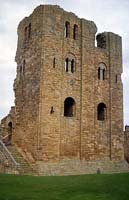| |
 |
Scarborough Scarborough Castle |
The castle at Scarborough on the east coast of Yorkshire stands on a high headland overlooking the North Sea. There are steep cliffs to the north and east, and a deep ravine lies to the south. Its defendable nature had already attracted prehistoric settlers to the site and the Romans built a fortified tower here. In 1066 the local population may have sought refuge on the headland when the Norwegian king, Harald Hardrada, sacked Scarborough during his ill-fated attempt to seize the English throne.
In the 1130s William le Gros, Count of Aumale founded the Norman castle by enclosing the western side of the headland with a bank and ditch, and building a tower on the site of the present keep. Le Gros was created Earl of Yorkshire by King Stephen in 1138, but in 1155 he was forced to yield the castle to Henry II who, according to the records of royal expenditure, began rebuilding in 1159.
Henry's principal structure was the magnificent keep. Its west wall was lost in the 17th century English Civil War, but the building still stands c. 30m (110 feet) high from ground level to the top of the corner turrets. The main entrance was on the first floor, as is usually the case in keeps of the Norman period. At Scarborough the entrance was, in addition, guarded by a subsidiary building within which there was a chapel above the gateway. The first floor of the keep itself served as the hall for the royal household. Its appointments included a fireplace and latrines which also existed on the second floor where there were two chambers forming private quarters.
Other buildings stood close to the keep within an inner bailey. The walling of the bailey was probably completed in the reign of King John.
Bibliography
Goodall, J.A.A., 2000. Scarborough Castle (English Heritage)
Pevsner, N., 1966. The Buildings of England, Yorkshire: the North Riding (London, Penguin), 324-6